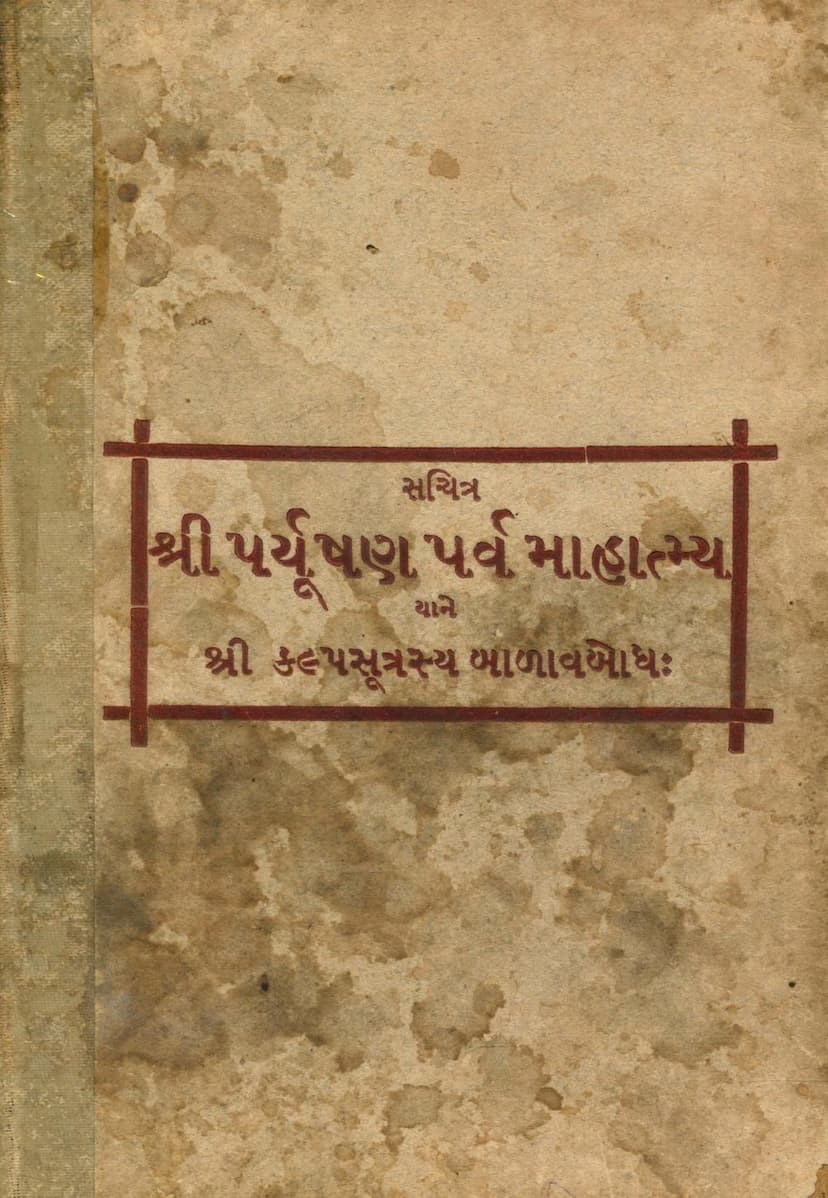Paryushan Parv Mahatmya Yane Kalpsutrasya Balavbodh
Added to library: September 2, 2025

Summary
This Jain text, "Paryushan Parv Mahatmya Yane Kalpasutrasya Balavbodh," authored by Gyanvimalsuri and Udaysagar, and published by Amrutlal Oghavji Shah, is a detailed guide and commentary on the significance of the Paryushan festival and the Kalpa Sutra, a fundamental Jain scripture. The book aims to provide a comprehensive understanding of these important aspects of Jainism, particularly for a younger or less learned audience, as indicated by the "Balavbodh" (child's understanding) in the title.
Here's a breakdown of the content based on the provided pages:
Core Purpose and Audience:
- The book is designed to explain the importance and rituals of Paryushan Parva, a major festival in Jainism, and to make the Kalpa Sutra accessible to a wider audience.
- It serves as an educational tool, especially for those in smaller towns or villages where access to learned monks or detailed explanations might be limited.
Content Highlights:
-
Paryushan Parva Significance: The text elaborates on the spiritual importance of Paryushan, often referring to it as "Parva Paryushana." It emphasizes engaging in austerities like "Chhath" (fasting for six days) and "Aatham" (fasting for eight days) and bringing the Kalpa Sutra into homes with great reverence. The ultimate aim is to increase punya (merit).
-
Kalpa Sutra and its Reading:
- Significance: The Kalpa Sutra is identified as a key scripture that is traditionally read during Paryushan.
- Reading Rituals: The book details specific rituals associated with the reading of the Kalpa Sutra, including requesting the text from a guru, spending nights awake with the scripture, bringing it back to the guru with fanfare, and listening to the readings with offerings.
- Benefits: Reading or listening to the Kalpa Sutra is said to lead to liberation within eight lifetimes. It's also described as a remover of sins and a fulfiller of desires, granting the happiness of celestial realms and ultimately leading to liberation.
-
Commentary and Explanations:
- Balavbodh: The commentary, likely authored by Udaysagar, is intended to be easily understood, using engaging stories and explanations.
- Illustrations: The title page indicates the book is "Sachitra" (illustrated), suggesting the presence of visual aids to enhance understanding.
- Structure: The text includes a detailed index listing chapters and their corresponding page numbers, covering a vast array of topics related to Jain history, cosmology, biographies of Tirthankaras, and key concepts.
-
Key Jain Concepts and Narratives:
- Tirthankaras' Lives: The book recounts the lives and deeds of various Tirthankaras, including Lord Mahavir (his 27 lives), Lord Rishabhdev (his 13 lives), Lord Parshvanath (his 10 lives), and Lord Neminath.
- The Four Ages (Yugas): The concept of the descending cycle of time and its characteristics is touched upon, particularly in relation to the Tirthankaras' lives and the differences in their practices.
- Swarams (Dreams): A significant portion of the book is dedicated to interpreting dreams, particularly the fourteen auspicious dreams experienced by the mothers of Tirthankaras, detailing their meaning and the virtues they signify.
- Thirty-two Llakshanas (Virtues/Marks): The text lists auspicious physical marks and characteristics indicative of spiritual attainment.
- Ten Types of Ascetics (Yati Dharma): It outlines ten different categories of ascetics and their associated rules and practices ("Kalpa").
- The "Ten Wonders" (Dasha Achherā): The book explains ten "wonders" or unusual events associated with the lives of Tirthankaras, highlighting the divine and extraordinary nature of their births and lives.
- Stories and Parables: Numerous stories are woven throughout the text to illustrate Jain principles, moral lessons, and historical events. Examples include the story of King Naganaketu and the eight-day fast, the tale of Megh Kumar, the story of the merchant Kartik Shethi, the life of Malli Kumari, the explanation of the Tirthankara's character based on their birth circumstances, and the story of the wealthy merchant Nagketu.
- Specific Rituals and Practices: The text mentions practices like "Attham Tap" (fasting for eight days), "Vashiḍan" (annual charity), "Diksha Utsav" (initiation ceremony), and "Keval Mahotsav" (enlightenment ceremony).
-
Linguistic Style: The book uses older Gujarati, which the publisher states was retained for authenticity and is generally understandable.
-
Historical Context: The publication date (Samvat 1996, i.e., 1940 CE) and the mention of the second edition in Gujarati type indicate its dissemination in the mid-20th century. The inclusion of a list of major patrons and subscribers highlights the community support for this work.
Overall Impression: "Paryushan Parv Mahatmya Yane Kalpasutrasya Balavbodh" appears to be a valuable resource for understanding Jain festivals and scriptures. It combines scriptural explanation with engaging narratives, making complex spiritual concepts accessible. The emphasis on the significance of Paryushan and the detailed exposition of the Kalpa Sutra and the lives of Tirthankaras suggest its aim is to foster devotion and knowledge within the Jain community.